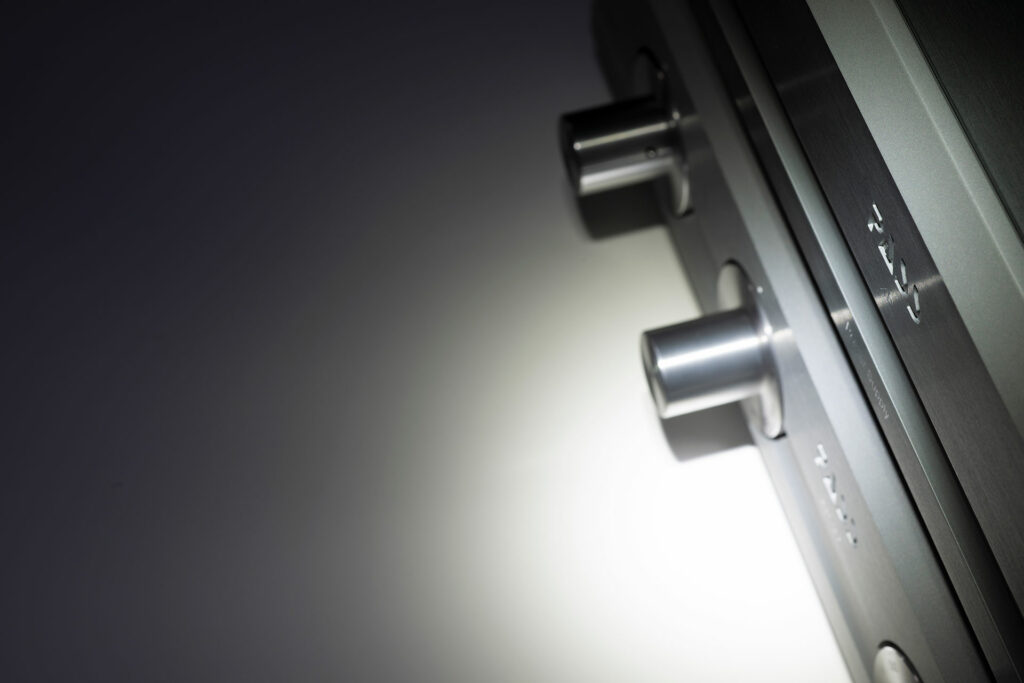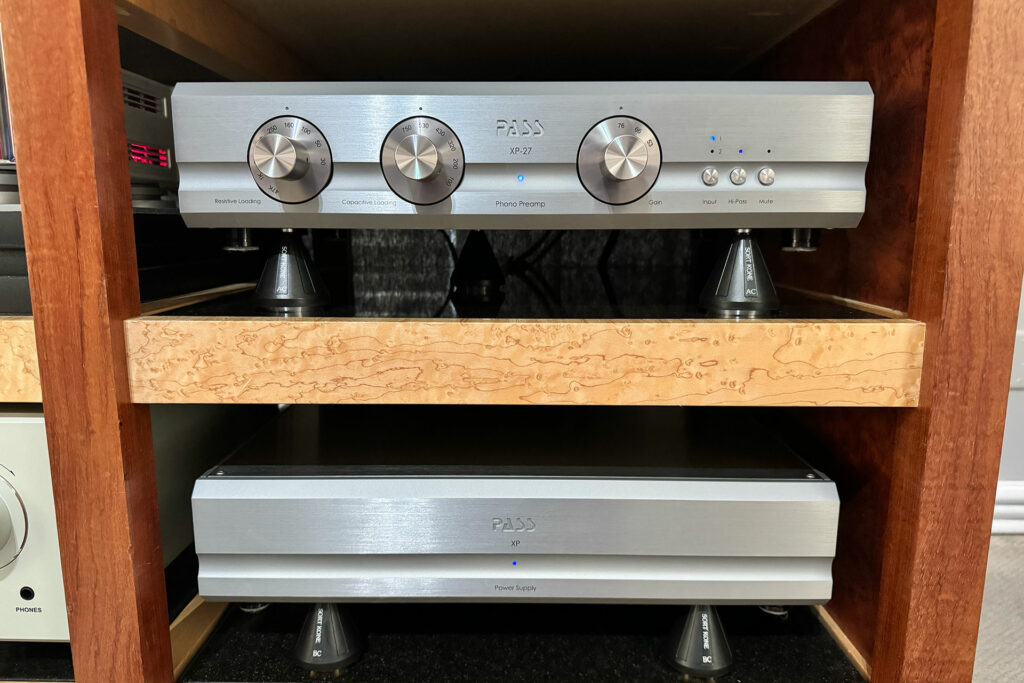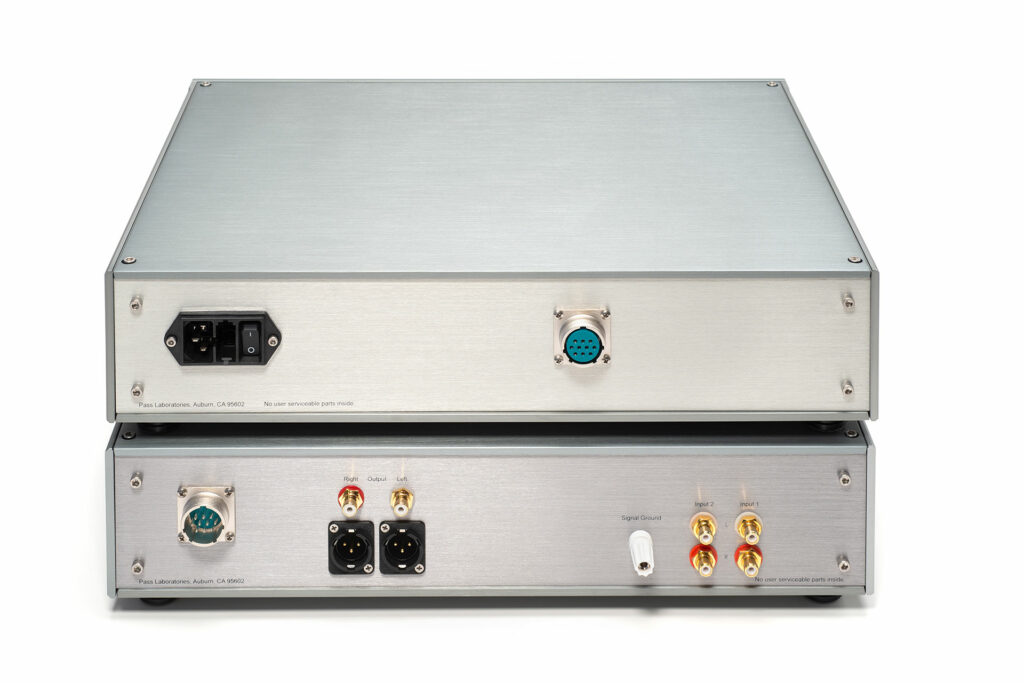Pass Labs has long been known for innovation, build quality, performance and perhaps, to many audiophiles, value. When I reviewed the highly capable Pass Labs XP-17 Phonostage (read the review), I quickly became convinced, enamored even, of the performance and workmanship of this component. And while for some, possibly many, a $4,500 phonostage may sound very expensive, others will see it as an outstanding value proposition with its features and performance, versus other brands/models on the market.
In this review, we will up the ante, as our focus now becomes the even more capable, more highly engineered, and yes, even more expensive Pass Labs XP-27 phonostage. Comparing cost alone, the Pass Labs XP-27 is $7,575 more expensive than its little brother, the XP-17. However, both follow a similar design aesthetic. The XP-27 offers tremendous performance and a host of features. At the same time, it is intended for mid-level-and-up audio systems with a superior analog section. All of this begs the question – how does the Pass Labs XP-27 measure up? That’s what we are here to answer…

What Makes the Pass Labs XP-27 Phonostage So Special?
This particular question is partially answered as soon as the phonostage is removed from the shipping carton. Not only is the XP-27 packaging very well designed, in separate boxes are two completely separate chassis. In one chassis reside the power supply, low-noise double-shielded toroidal transformers, and any AC power regulation circuitry. In the second chassis are the control circuits used for cartridge setup and use.
- An included nine-conductor, silver-clad oxygen-free copper cable connects both chassis. This cable only carries power, never an audio circuit. The cable is long enough to potentially allow placement, depending on the system, of the power supply half to be positioned far enough away from a turntable to help eliminate the cartridge picking up transformer noise. Let’s face it, no vinyl lover likes a feedback loop.
- There are both RCA and XLR connections for output to a preamp. There are also two left and right RCA inputs for two separate tonearms. One chassis ground accommodates both inputs. Electrical outlets complete the rear-mounted connections.
- In addition to having dual chassis, the Pass Labs XP-27 is also a fully-balanced, dual mono from input to output design, completely capable of providing lower radiated and mechanical noise.
- The stunning build quality is also immediately apparent. Featuring an all-machined aluminum chassis at this price point is noteworthy. Even with two separate housings, each chassis has an appreciable weight and mass, which imbues a feeling of quality.
- The Pass Labs XP-27 will accommodate two different tonearms. I looked, and there is just not a wealth of $12,000 phonostages offering this capability. Being able to switch between two different tonearms allows the use of a higher quality, and more expensive, two-arm turntable with only one phonostage. For some, use of the Pass Labs XP-27 allows more financial resources to be devoted to the turntable, tonearm and cartridge, while still having a very capable, cost-effective audiophile phonostage.
- There is a high-pass filter designed to help abate low-frequency noise. This is especially useful if, like me, you have two large, rather powerful subwoofers in somewhat close proximity to the turntable, in my case, in each corner beside the audio rack. I switched this filter on and off multiple times and, without question, it made a positive difference in the low-frequency quality of an LP.
- There is also a front-mounted mute button, which proved helpful, meaning preamp volume need not be altered when the tonearm lowers onto the lead in groove of an LP.
- The gain section of the Pass Labs XP-27 is rated at 56dB, 66dB and 76dB. Just as with other Pass Labs models, the inclusion of a high-gain setting helps with the use of increasingly popular low-output moving coil cartridges.
- As with all Pass Labs phonostages, the XP-27 can accommodate Moving Coil (MC), Moving Magnet (MM) and Moving Iron (MI) cartridges, with no required user selectable differentiation between each type.
- Resistive Load settings range from 30 ohms to 47k ohms. While 47k ohms is the overwhelming choice for MM cartridges and the remainder for MC versions, all resistive settings will work with any cartridge loading requirements. Sonics, of course, may vary.
- The Pass Labs XP-27 expands the availability of capacitive, or reactive, loading over the three options on the XP-17, with six choices ranging from 100pF up to 750pF.
- All selection options for gain, resistive loading and capacitive loading are performed by front-mounted round knobs.
Why Should You Care About the Pass Labs XP-27?
There will likely always be a certain faction of audiophiles who see no need to invest more than a couple of grand at most (maybe even one grand) in the analog LP section of their system. Without question, this phonostage is not for them. Others, those with a more finely developed yearning for increased performance from a turntable, obviously seek the biggest bang for the lowest buck. For these enthusiasts, there is a proliferation of available world-class phonostages in the $20,000, $40,000 and up price category. For that matter, the Pass Labs XS Phono, a world-class product in its own right, retails for $45,000, which easily places it in a best of the best classification. At $12,075, the Pass Labs XP-27 offers a host of useful features and, importantly, operates with a great deal of attention paid to lower distortion. Even RIAA performance is accomplished at much lower distortion levels than previous versions in the same price class. With all of these attributes, as mentioned above, using the Pass Labs XP-27 offers the possibility of using a much better turntable, tonearm and cartridge at a lower total analog cost, while still achieving a remarkable level of sonic aptitude.

Some Things You May Not Like About the Pass Labs XP-27
- For me, it was not relevant, as I had no space issues, but there are those audiophiles who have a limited amount of room in which to place an audio system. A two-box component, one in which the preferred placement is not one half directly on top of the other, may be a problem. Had I chosen to do so, however, both chassis halves would have fit on one shelf in my audio rack.
- There is no active display screen. Pass Labs simply sees no need for one. Because the unit is designed for optimized settings and then to be left alone, having a display screen is not deemed as a required function. Power, tonearm, mute and filter are all designated by small blue front-mounted pilot lights.
- There is no remote control. In fact, none of the Pass Labs phonostages have a remote. Additionally, the unit is designed to be left powered on through its entire service life (except for prolonged inactivity). If the settings will very seldom be changed, and the power is left on continuously, a remote is therefore not viewed as a requirement. The term “set it and forget it” may well apply.
- When switching from tonearm one to tonearm two, all gain and load settings must manually be readjusted if necessary. The Pass Labs XP-27 does not remember them automatically.
Listening With the Pass Labs XP-27 Phonostage…
Historically, imaging ranks as one of my favorite audio attributes. I particularly enjoy sitting in the listening chair while being greeted by a veritable wall of sound. Some analog phonostages have come close to replicating the phenomenal image presentation I have in my digital section. With the Pass Labs X-27, imaging was consistently equal to anything I routinely hear when playing a digital recording. Image presentation left to right spanned the maximum distance of 22 feet in my audio room. From the sweet spot, I heard layers of instruments from about 14 feet away to about 23 feet away – with laser-like pinpoint accuracy, I might add. Even when positioned at the rear of my 32-foot-long audio room, image presentation, while not quite as precise, was excellent. I also felt the frequency response was, again, equal to digital. Using the Audio Tools app for my iPad, a real-time analyzer check confirmed what I was hearing – from lows to highs, analog frequency range was effectively on par with digital. In fact, the basics of what I heard on analog very nearly equaled my digital presentation. This is not something I have noticed with past phonostages in my system. In this respect, the Pass Labs XP-27 was the first phonostage to do so.
Comparing the Pass Labs XP-27 to its smaller sibling, the XP-17, my assessment is more of the same. There are obvious similarities, but from the standpoint of dynamics, clarity, imaging and musicality, the XP-27 is significantly better. At more than twice the cost, frankly, it should be.
I try to tell myself I’ve moved on from Lynyrd Skynyrd, but I seem to always circle back around. On the live set, One More from The Road, recorded live at Atlanta’s Fox Theater in 1976, track number two on side three, “Call Me The Breeze,” lead singer Ronnie Van Zant and company sounded magnificent. Sporting a three-guitar lineup, one guitar was far to the right, one far left, one was somewhere in between, and all three presented what on stage would be closer to the front. Drums and bass imaged more towards the back. Van Zant’s vocals actually moved around, just as if I was watching him on stage. The accuracy was spot on and, right in the beginning, someone whistled with sufficient dynamics that I was actually startled. This track is why I keep coming back to this group, time and again, despite most of the original band members now being deceased. Say what you will about the difference between digital and analog, with the Pass Labs XP-27, I thought this track, and this album, sounded spectacular – yet it still sounded like an LP is supposed to sound.
Originally recorded live in 1974 at the Anaheim Convention Center in California, the 2016 remaster of Emerson, Lake & Palmer’s release of Welcome Back My Friends to the Show That Never Ends – Ladies and Gentlemen showcases how much sound can come from essentially three musicians. Track one on side one, “Hoedown,” begins with all three going full-tilt. Never mind waiting for a song to develop. Nope, this one simply explodes, with Keith Emerson’s keyboards, Greg Lake’s bass and guitar work, and Carl Palmer’s drums and percussion. I had a hard time trying to slow this song down in my mind, as it was presented with such a frenetic pace. Most importantly, this is how it was performed live, how it was recorded live, and through the Pass Labs XP-27, was precisely how it was played back on my system. Once again, I clearly heard the delineation of instruments presented in their own space. The keyboard’s notes sailed through the lower registers to the upper with no confusion or congestion at all. Emerson’s mastery of the Hammond B3 and the Moog Synthesizer was completely captivating – and positively explosive. Following closely along were the guitar and percussion sections, with enough transient instrumentation, heard very clearly, I found myself trying to figure out what all the instruments were. Call this track and this recording ‘70s English Prog Rock. Call it whatever. On my system, this LP on my analog section with the Pass Labs XP-27 in the loop sounded simply outstanding.
Will the Pass Labs XP-27 Phonostage Hold Its Value?
I tend to assess the value of previously-owned audio gear by how much of any one component may be found on the used market. I looked at several outlets for used gear, two popular websites, and one company in the business of buying and selling of used gear. Not one Pass Labs phonostage was listed for sale in any of them. My guess is, if you are looking to purchase a used Pass Labs phonostage, and you see one for sale, it might be wise to act rather quickly. If you are going to offer one for sale, better keep the packing tape handy, because it will likely not last very long before being sold. Based on this, yes, Pass Labs phonostages will hold their value very nicely, we predict.

What Is the Competition for the Pass Labs XP-27 Phonostage?
For the sake of being consistent, I have tried to only list competing brands with a two-chassis configuration. I also tried, where possible, to include models with a two-tonearm capability.
In terms of competition, I first thought of the Gold Note PH-1000 LINE. This device might well be considered the Swiss Army knife of phonostages. It offers gain capability of up to 65dB, with fine adjustments of plus or minus 0db up to 9dB for each setting. Like Pass Labs, the Gold Note PH-1000 LINE also has capacitive and resistive load options. What possibly sets the PH-1000 apart from most is its ability to offer a dozen or more EQ settings based on past RIAA curves. Stereo and mono are user-selectable, as is L-R channel swap, a rumble filter and a headphone jack. It also has XLR and RCA outputs and includes a remote. Perhaps the best feature of the PH-1000 is its ability to input two RCA tonearms and one XLR balanced version. A very unique aspect is that everything can be controlled by one front-mounted round knob. The standard version of the Gold Note LH-1000 LINE is $11,999. A separate power supply retails for $6,599.
Clearaudio is a leader in moving coil cartridges, and they also have a complete line of turntables, so it only follows they should offer a phonostage. The Clearaudio Absolute Phonostage is a two-box solution, meaning the power supply and transformer are in one enclosure, and the control circuitry is in a separate enclosure. Interestingly, this device only accepts moving coil cartridges – moving magnet users need not apply. Not accepting a MM cartridge is somewhat surprising, as Clearaudio has a series of MM cartridge designs in their lineup. Clearaudio further claims all cartridge loading on the Absolute Phonostage is automatic and optimizes all settings, regardless of the manufacturer, amplification requirements or load settings, thus eliminating the need for manual settings. This device seems obviously intended for use with an all-Clearaudio system – turntable, tonearm, cartridge and phonostage. If this is the intended use, it will no doubt function flawlessly. Analog components by a different manufacturer or design may present compatibility issues. The Clearaudio Absolute Phonostage retails for $17,499. It should be noted Clearaudio does offer lower-cost phonostages designed to work with MM cartridges.
Following the two-box phonostage theme, another very worthy offering is the Audio Research REF 10. Being an ARC component it is an all-tube design. Gain is selectable up to 74dB on MC. Impedance is fixed for MM at 47K ohms at 100pF. For MC cartridges, impedance selection ranges from 50 ohms to 1000 ohms. It also features RIAA equalization based on early Columbia and DECCA recordings. There are those vinyl enthusiasts who feel an LP and a tube phonostage are a perfect match, as opposed to a solid-state variant. While that is for the user to ultimately decide, a tubed phonostage and turntable are intended to capitalize on the “warm” sound of an album. The REF 10 has capability for only one tonearm at a time, and retails for $35,000.

Final Thoughts on the Pass Labs XP-27 Phonostage…
At the beginning of this review, I mentioned value. I will admit for some, any audio component with a retail cost of $12,075 may hardly seem like a value in any respect. However, if a turntable, tonearm and cartridge investment of, say, $20,000 and up is going to be considered, then this phonostage is a very wise choice. Yielding remarkable sonics across the entire frequency range, the ability to user-select a variety of gain options, capacitive and resistive load settings, the ability to use two tonearms, a high-pass filter and mute button, all user selections on the front, and low noise due to separate enclosures, and have all this for $12,075, well below other competitors with similar features, in my estimation, the Pass labs XP-27 is a standout. Not only will it deliver a pleasing sonic picture across a wide variety of LPs, it does so with an ease and simplicity that allows the user to focus on what is principally important – listening to music. When compared to other brands with similar features, the Pass Labs XP-27 will more than hold its own in consideration of the value/features/capability metrics. Any vinylphile considering an upper-level analog section would be well-advised to audition the Pass Labs XP-27 phonostage. Without question, I found it to be a standout in my system.



